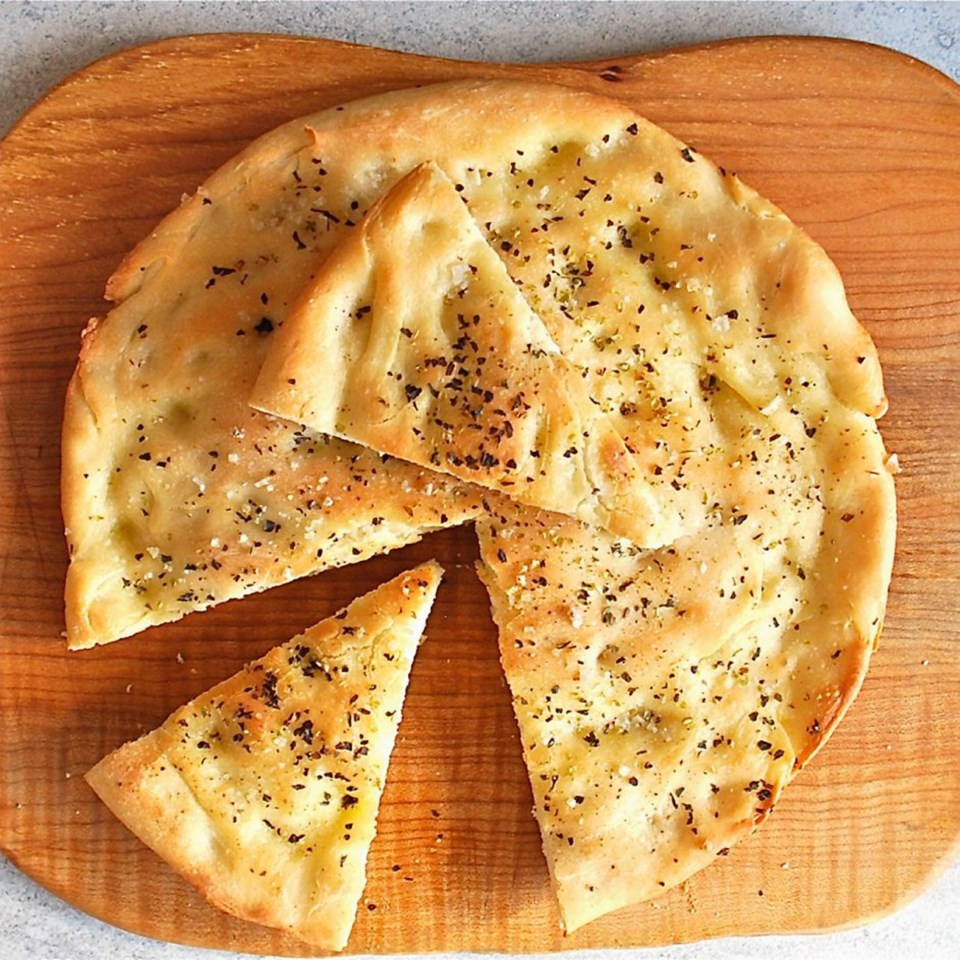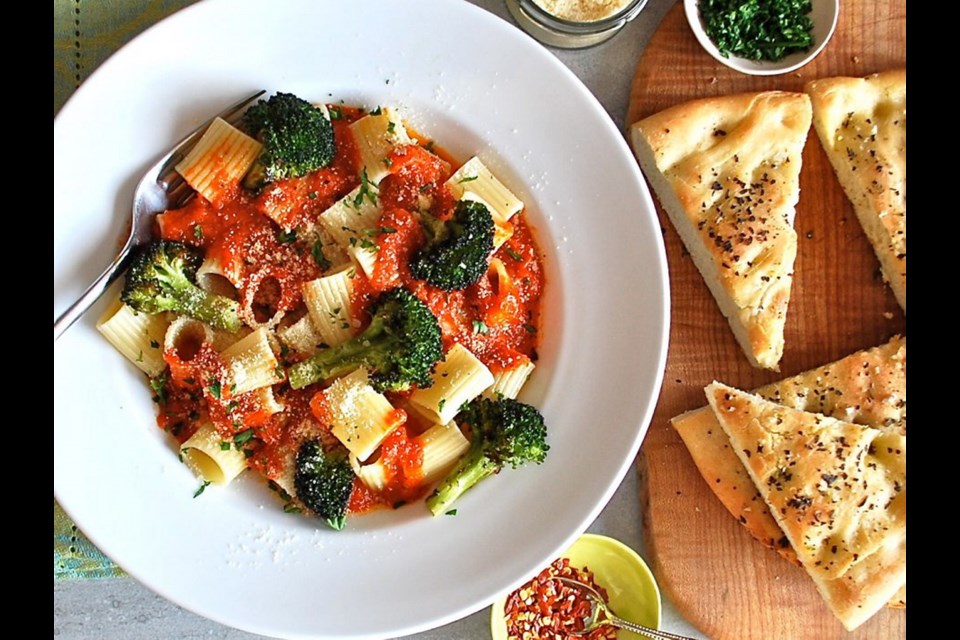Some of the most satisfying meals are the least pretentious. A good example is a hot bowl of pasta served with a flavourful sauce, simple garnishes and good bread.
The pasta can be any type you like — rigatoni, fettuccini, penne or another shape. All will taste great topped with my easy-to-prepare marinara sauce.
Marinai is the Italian word for sailors. Legend suggests one reason this sauce is called marinara is because, eons ago, Italian sailors’ wives, seeing their husbands’ ships returning home, would quickly make it so their husbands could enjoy a hot meal not long after getting home.
In my version of marinara sauce, the key ingredient is canned Italian San Marzano plum (roma) tomatoes, which are sold at Italian/Mediterranean-style food stores and many supermarkets
These tomatoes are richly flavoured, deep red and ripe, making them great for marinara sauce, which is also flavoured with herbs, garlic and onion.
Once the pasta is cooked, set in serving bowls and topped with marinara sauce, it’s accented with such things as roasted broccoli florets and Parmesan cheese. The smoky-tasting broccoli adds a nice green colour to the bowl, and the cheese, of course, always makes pasta taste more marvellous.
The bread I served with the pasta was focaccia that I baked in a cast-iron skillet. It’s light golden and crusty and perfect for mopping up any marinara sauce left in the bowl.
Pasta with Marinara Sauce and Roasted Broccoli
Your favourite type of pasta, cooked, then topped with a zesty tomato sauce and bright green bits of smoky-tasting broccoli. Serve the pasta with foccacia bread (see recipe below).
Preparation time: 15 minutes
Cooking time: About 30 minutes
Makes: Two servings
12 to 14 small broccoli florets (see Note)
1 Tbsp extra virgin oil
• salt and freshly ground black pepper to taste
175 to 200 grams dried pasta, such as rigatoni, penne or fettuccini
• marinara sauce, to taste (see recipe below)
• grated Parmesan cheese, to taste
• chopped fresh parsley, to taste
• crushed red pepper flakes, to taste
Preheat oven to 450 F. Line a sided baking sheet with parchment paper. Bring a large pot of lightly salted water to a boil over medium-high heat.
Place broccoli, oil, salt and pepper in a bowl and toss to combine. Set broccoli on the baking sheet. Roast 10 minutes, then turn each broccoli floret over and roast five minutes more, until tender and lightly charred-looking around the edges.
While broccoli roasts, add the pasta to the boiling water and cook until just tender (consult package for suggested cooking time).
When cooked, drain the pasta well, then divide it between two shallow serving bowls. Top the pasta with marinara sauce, to taste. Now set six or seven roasted broccoli florets in each bowl. Serve pasta with Parmesan cheese, parsley and red pepper flakes, for sprinkling on it, to taste.
Note: The broccoli florets I used were about 1 1/2 to 2-inches wide at the tip, and 2 to 2 1/2-inches long.
Eric’s options: If you love tangy cheese, you could also top bowls of the pasta with some nuggets of soft goat cheese.
Marinara Sauce
Richly flavoured with herbs and garlic, this simple sauce can be ladled over your favourite pasta, including gluten-free types. Any leftover sauce will freeze well.
Preparation time: 10 minutes
Cooking time: About 35 minutes
Makes: About 2 1/2 cups
1 (28-oz/798 mL) can Italian San Marzano whole plum (roma) tomatoes
2 Tbsp extra virgin olive oil
1 large garlic clove, minced
1/4 cup finely chopped onion
1/2 tsp dried oregano
1/2 tsp dried basil
• pinch fennel seed (optional)
• pinch granulated sugar
• salt and freshly ground black pepper to taste
Place the tomatoes and their juices in a bowl. Use your hands to squash and break tomatoes into chunks.
Heat the oil in a medium-sized, heavy-bottomed pot set over medium heat. Add the garlic and onion and cook until both are fragrant and light golden, about three to four minutes. Mix in the basil, oregano and fennel seed, if using, and cook and stir 15 to 30 seconds more.
Add the tomatoes and sugar. Bring sauce to a slow simmer, adjusting the heat as needed to maintain that slow simmer (small bubbles should just break on the surface). Loosely cover the pot and simmer sauce 30 minutes. (Do not completely cover the pot, as steam rising from the simmering sauce must be allowed to escape.)
Purée the sauce in a blender or food processor, or do so right in the pot with an immersion (hand) blender. Taste the sauce, and season with salt and pepper, as needed, and it’s ready to use.
Skillet Focaccia

Olive oil- and herb-flavoured bread, baked in a skillet, until crusty and golden.
Preparation: 25 minutes, plus dough rising time
Cooking time: 20 to 22 minutes
Makes: One 10-inch round loaf
2/3 cup lukewarm (not hot) water
1 tsp active dry (traditional) yeast
1/2 tsp granulated sugar
1 Tbsp plus 4 tsp extra virgin olive oil (divided), plus more for the mixing bowl
1 1/2 cups all-purpose flour
1/4 tsp salt
1/4 tsp dried oregano
1/4 tsp dried basil
• coarse sea salt and freshly ground black pepper, to taste
In a large bowl, or in the bowl of a stand mixer fitted with a dough hook, combine the water, yeast and sugar. Let mixture stand five to 10 minutes to dissolve the yeast, then mix in 1 Tbsp olive oil.
If using a stand mixer, add 1 1/2 cups flour and 1/4 tsp salt and mix on medium speed until the dough is smooth and pulls away from the sides of the bowl (the dough should be fairly soft and a little bit sticky). Mix and knead the dough for another five minutes.
If mixing the dough by hand, slowly add one cup of the flour and the 1/4 tsp salt, working it into the yeast/water mixture with a spoon until the dough loosely clumps together. Lightly dust a clean work surface with the remaining flour. Gather the dough, scraping the sides of the bowl if necessary, and set it on the counter. Dab it lightly in the flour to coat it, and then knead for six to eight minutes, until the dough is smooth, but still slightly sticky.
Lightly coat the bottom of a deep bowl with olive oil. Place the kneaded dough in the bowl, cover with plastic wrap, and let rise at warm room temperature until doubled in size, about 75 to 90 minutes.
Brush the bottom of 10-inch cast iron or other ovenproof skillet with 2 tsp olive oil. Place the dough in the skillet. Press the dough into a round that fills the bottom of the pan. Now use your fingertips to make numerous shallow indentations into the top of the dough. Drizzle dough with remaining 2 tsp olive oil, then sprinkle with oregano, basil, coarse salt and pepper.
Let dough rise in the skillet 40 minutes (it won’t double in size again, but that will occur when baked).
Set an oven rack in the middle of the oven. Preheat oven to 425 F. Bake the focaccia for 20 to 22 minutes, or until puffed and golden. Let rest in the pan a few minutes, then lift out of the pan and set on a cutting board. Serve foccacia warm or at room temperature, cut into wedges.
Eric Akis is the author of eight cookbooks. His columns appear in the Life section Wednesday and Sunday.



